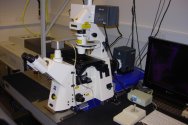Equipment
Spinning disk confocal microscopes
The Yokogawa Spinning Disk microscopes allow multicolor fluorescence image acquisition at high speed with low light, by using sensitive Electron-Multiplier-CCD cameras. The systems provide ideal imaging conditions for living cells or weak fluorescent signals.
To facilitate the work-flow both systems operate under Metamorph software on a Nikon inverted microscope equipped with auto-focus and automated stage with multipoint memory and piezo-controlled xyz submicron accuracy. Fast dynamics of fluorescent molecules in cells or samples can be monitored for extended time periods and in 3-dimensions. A FRAP-unit allows local subcellular bleaching to study molecular dynamics. A heating/CO2 unit on stage allows to keep ideal conditions for living animal or human cells.
The specifications of the hardware of the Roper and Andor spinning disk systems are listed in the Technical Details paragraph.
Technical details
| Part | Andor-Revolution SD | Roper SD |
|---|---|---|
| Install date | 2013 | 2009 |
| inverted microscope | Nikon Ti Eclipse PFS3 | Nikon Ti Eclipse PFS2 |
| diode 405 nm CW | 100 mW | -- |
| DPSS 488 nm CW | 50 mW | 50 mW |
| DPSS 561 nm CW | 50 mW | 50 mW |
| diode 640 nm CW | 100 mW (640 nm) | 100 mW (633 nm) |
| EM-CCD camera | Andor iXon888, 1024x1024, 13x13 | Photometrics Evolve 512x512, 16x16 |
| xyz stage | piezo ASI XY- LE, z- 150um | piezo ASI |
| objectives | 10-20-60-100 | 10-20-60-100 |
| emission filters | on request | on request |
| shutter | Rotr shutter wheel 30 ms | Yokogawa shutter |
| transmitted light | CoolWhite LED | halogen |
| UV | Intensilight c-HGFIE | Hg |
| FRAPPA | -- | YES |
| 5% CO2 and 37C | YES, Tokay Hit | -- |
Information obtained by light microscopy
Localisation. Specific staining or fluorescent labels allow temporal and spatial localisation of your (bio)molecule of interest. A range of fluorescent probes can be combined for simultaneous multicolor, multidimensional image acquisition.
Morphology and 3D reconstruction. The shape, 3D volume and interaction of molecules, organelles or tissues can be derived from optical sections from confocal microscopy.
Analysing (sub)micron dynamics. Rapid image acquisition of fluorescent probes allows imaging (relative) dynamics that can be analysed in kymographs. FRAP studies give insight in fluorescent displacements and allow quantification of protein dynamics.
Polarization microscopy. Biopolymers are made out of molecules arranged in a specific order and as a consequence have a birefringent characteristic. Protein crystals, collagen, cell wall polymers, microtubules or actin filament bundles are examples. Crystallographic and polymer orientation information can be obtained.
Applications
Application areas are in structural analysis, protein interactions, signal transduction, life sciences, single molecule detection, biochip development, food processing, biophysical studies and colloid chemistry.
Ancillary equipment
Ancillary equipment for sample preparation includes (cryo-)microtomes, micro slicer, needle puller, micro manipulation and microinjection.
Presentation download
In addition to the spinning disk confocal microscope, Wageningen University & Research, Shared Research Facilities offers the use of:
